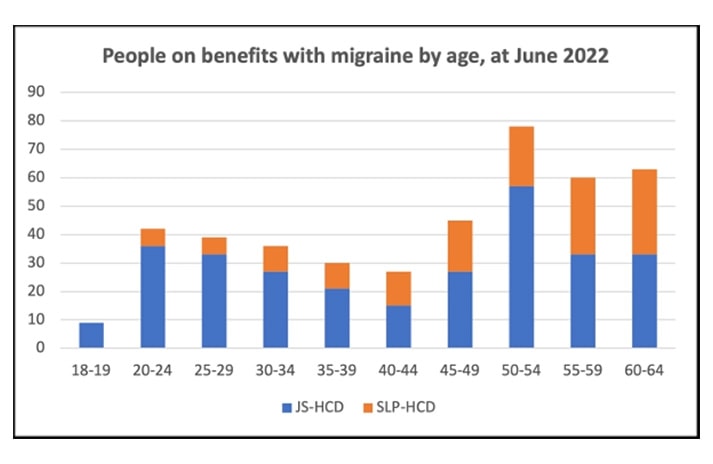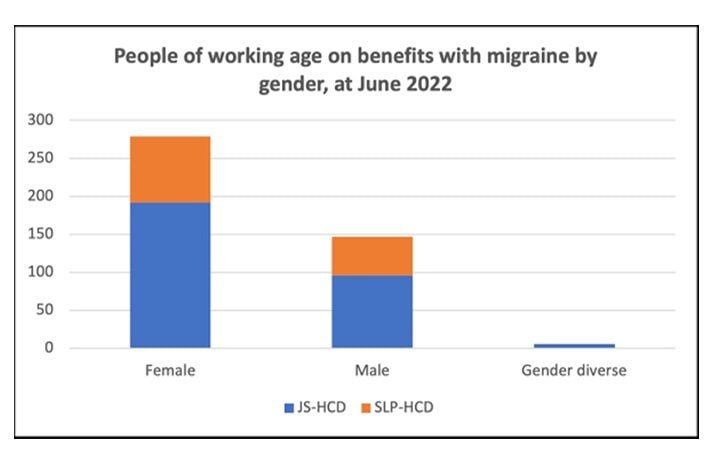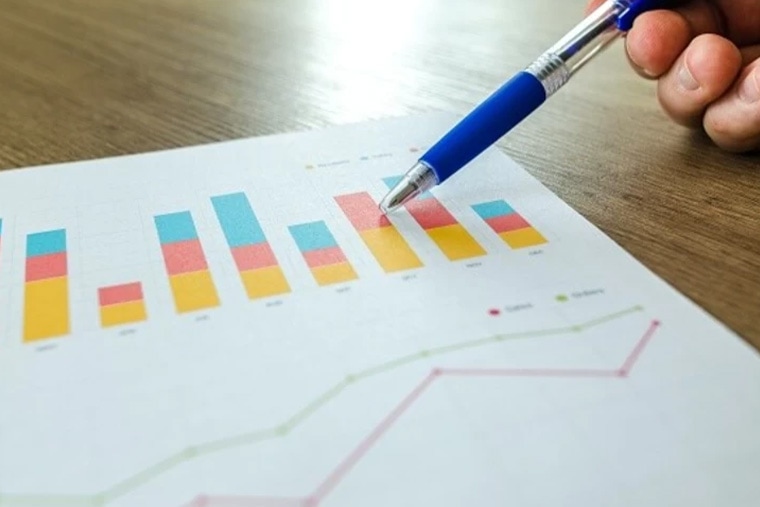If you’ve ever wondered how many people in Aotearoa New Zealand are on a benefit with migraine disease, we have some answers, but many more questions.
We asked the Ministry of Social Development for the number of people with migraine on a Supported Living Payment (SLP-HCD), or a Jobseeker – Health Condition or Disability (JS-HCD) payment. The SLP-HCD is for people who are unable to work on a long-term basis because of a health condition or disability. The JS-HCD payment is for people who can only work part-time or are unable to work ‘at the moment’ because of a health condition or disability.
At June 2022, 429 people of working age (18-64 years) who were on one of these benefits had migraine listed as an ‘incapacity’ (a condition which limited their ability to work). Around two thirds were receiving the JS-HCD and one third was receiving the SLP-HCD – so for the majority, migraine was not considered to be limiting their ability to work on a permanent or long-term basis.
Adults aged 50 years and older were most likely to receive a benefit, which could be surprising, as migraine affects people throughout their working life. We can only theorise as to why. Maybe people with migraine had been battling on with work and it finally became too difficult (with frequent or chronic migraine, it might only take another health condition to appear, or the onset of peri-menopause, for the wheels to come off). Maybe people with migraine who were supported by working partners became eligible for a benefit when their partner retired (or if the relationship broke up). For example, for someone in a marriage, civil union or de facto partnership, without children, they are only eligible for the SLP-HCD if the household annual gross income is less than $56,309 (as of April 2022)(1).

Almost two thirds of people receiving a benefit with migraine were female, which is consistent with the fact that migraine disease is 2-3 times more common in females.

Almost two thirds of people receiving a benefit with migraine were European, and almost one quarter were Māori. Low numbers of Pacific Peoples could mean that Pacific Peoples are not being diagnosed with migraine appropriately (suggested by research in the 1990s, but this needs to be repeated) or not accessing benefits they are entitled to.

At June 2022, there were 170,763 working age people on a Jobseeker benefit – 0.17% of these had migraine. There were 97,710 working age people on a Supported Living Payment – 0.14% of these had migraine. (2)
Analysis from 2018 found that the commonest incapacities for people on a SLP were psychological or psychiatric conditions (35.5%), intellectual disability (11.1%) and musculoskeletal conditions (10%). (3) For Jobseeker, the top incapacities were also psychological or psychiatric conditions (48.2%), followed by musculoskeletal conditions (16%) and accident (5.4%) – which is curious, given the existence of the Accident Compensation Corporation.
There may be flaws in these numbers. There may be undercounting of people debilitated with migraine and receiving a benefit for another reason, without declaring the migraine. People may not be aware that they have migraine disease or that they might be eligible for a benefit. But considering how common migraine disease is and the amount of disability it causes, these numbers are extremely low. The numbers raise more questions than they answer.
As with everything about migraine in New Zealand, we need more research – to find out how many people with disabling migraine are eligible for benefit assistance (and how many aren’t, and why not), and why eligible people are not accessing it.
Anyone up for a research project?


